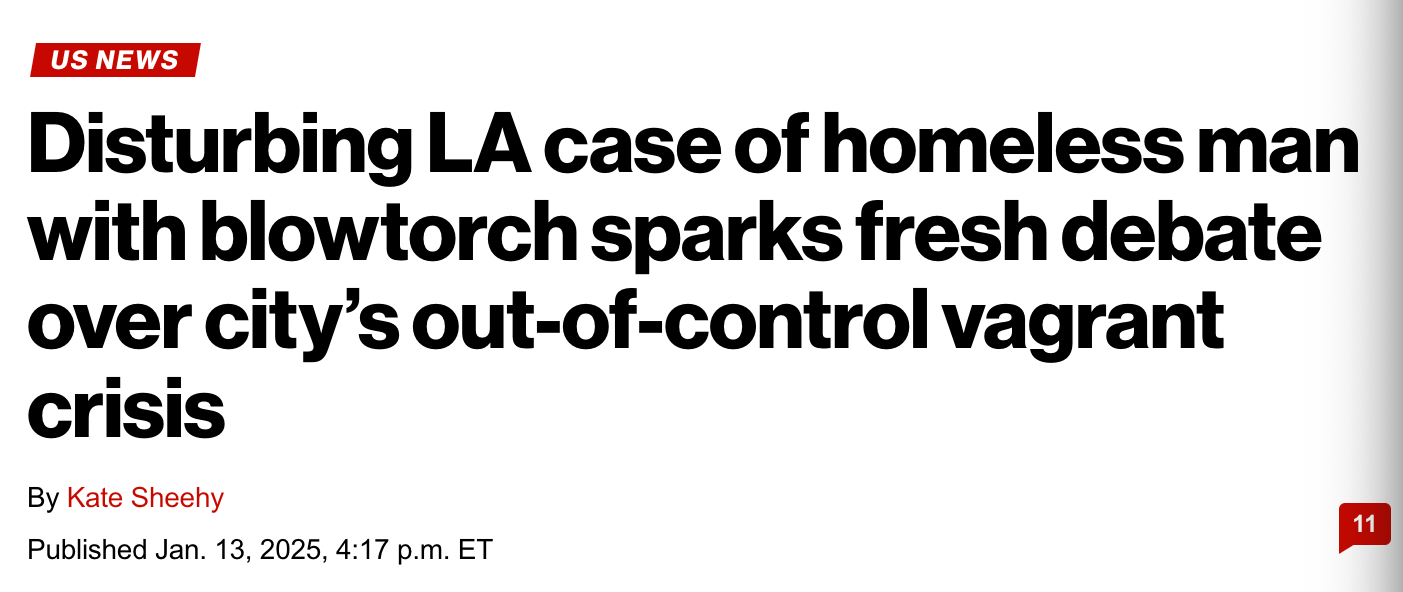Phoenix.
What The LA Fires Can Teach Us About Crisis Exploitation and Criminalising Homelessness.
Every time we watch ‘The Apocalypse’ play out in film or TV (see TWD or The 100), the main, mostly-white, seemingly middle-class characters adopt control, positioning themselves as the new leadership team or de-facto government - the ones to be trusted to police their emerging society. They’ll decide for themselves where the threat lies and how it will eventually need destroying. They’ll probably give a rousing speech or two, one that inspires an ‘us’ vs ‘them’ mentality despite having only just arrived on the scene and only just having put roots down. As art imitates life, we’ll always see a similar brand of self-centred entitled-ness embodied in members of our white upper-middle class, having been convinced all their lives of their increasingly close position to top positions, and in the event that society collapses, will assume their own authority.
When the wealthier members of society in LA, who have never once come across the homeless population in their daily lives and are so incredibly removed from it designate the most vulnerable members of society as the most ruthless – we witness a strange desire to manipulate the narrative for personal profit. The ‘rousing speeches’, that so far have been nothing if not a promotion of an ‘it’s us’ or ‘it’s them’ mentality weaponizing fear, repeatedly playing upon stereotypes about the poorest of citizens whilst ignoring the material environmental and infrastructural devastation found at the forefront of it all, simply maintaining the status quo. When our society repeatedly and consistently takes advantage of or facilitates collective crises, whether they’re ecological, political, social, or humanitarian, to maximise privilege for an individual, the fearmongering about the homeless now reads kind of like a series of publicity campaigns popping up all over the place.
At the moment, Californians are bracing for Santa Ana winds, which are likely to worsen the ongoing wildfires in the area. The largest fire, Palisades, having burned over 23,000 acres and being only 13% contained, has amassed a death toll of 24 so far, with 16 still missing. The fires, now among the costliest in U.S. history, have inflicted massive destruction, with authorities warning of "extreme fire behaviour" in the coming days. Then we have unofficial authorities warning of a different kind of ‘lawlessness’ that stereotypically, has been associated with poverty and economic desperation.
I had a particularly painful experience having to write notes on influencer Leo Skepi’s ‘advice’ to the general LA population in the research for today’s article, where 2.2 million likes pedestalised his advice;
“if you survived the fire congrats, this is round 2”.
His thoughts on a second wave of crime seem to underpin the narrative perpetuated all around, except his is a much louder, clearer voice than most.
He illustrates a state-wide purge scenario, stating the obviousness that is “This is not a time to chill out” (as the city burns before our eyes).
Then there was the dreaded and unmistakeable, “All these homeless people ‘been waiting’ for their moment (…) starting more fires”, tapping into the fears in the minds of a uniquely sheltered demographic, convinced of a violent homeless population waiting outside their windows to invade their homes and rob them of their possessions. Most disconcerting, though, was the passion in his voice as he told followers, “You know what to do, so do not hesitate to do it”, regarding… what exactly? I’m still not sure, but this part felt most of all like some kind of call to violence, not that his influence is that great (I hope).
Meanwhile, wildfires in Los Angeles stand to disproportionately impact the city's 75,000 homeless residents. According to Nnenia Campbell of the University of Colorado-Boulder’s Natural Hazards Center, the homeless currently struggle with limited access to information in addition to shelter, becoming excluded from a conversation in which they’ve become the focal point. Exacerbating the issue, existing shelters are not only filling with newly displaced people but are also at risk from the fires themselves. PATH, a homeless service provider, reported the need to evacuate four sites so far, displacing around 300.
Where the most denigrated are villainised, we see how they’re seen as expendable, too. California’s use of nearly 400 prison inmates as part of a 14,000-strong firefighting team elucidates what we’re always saying about prison or new slave labour. Incarcerated individuals, who now make up about 30% of the state’s firefighting force, are deployed to risk their lives for just $1 an hour despite being one of society’s most marginalised groups. Trained through the state’s Conservation Camps since 1946, these inmates ‘volunteer’ to work in firefighting but essentially work for free and receive limited food in return.
Right now, fear appears to define who counts as being worthy of protection, whether it’s physical, in the form of shelter, or whether or not they’re protected socially from the damage inflicted by stereotypes surrounding homelessness. Other than donating, or spreading awareness, what little we can do as those not directly impacted by the fires or those who sit watching everything take place in other countries, is to intentionally bypass misinformation and highlight harm where it actually takes place.
It would be easy enough if Leo Skepi weren’t as I mentioned before representative of a larger misconception around homelessness. Today I read The New York Post’s article ‘LA Homeless Man with Blowtorch’, stoking fears about the homeless population, telling us that this is more of an issue across institutional media outlets, rather than emerging from one, more out-of-touch or unserious perspective. The president-elect, along with local officials and firefighters continue to push for stricter measures, citing the dangers posed by encampments and continuing to endorse plans for ‘tent-cities’ proposing that reducing homelessness could reduce fire risks, when in reality, the stigma here lies far beyond the current crisis.
Mostly, criminalising homelessness makes no sense when so many will face this struggle now. Still, there are those we’re told to mourn for: celebrities who have lost second or third homes, whilst the portrait of the violent homeless man is illustrated in our minds. This more than anything signals to us a class issue (once again), in a ‘what’s fine when rich people do it but bad when poor people do it’ kind of way. ‘Othering’ homeless people is convenient at a time where many seem on the cusp of ‘class consciousness’, and even if I am overestimating an ability for the majority to ‘come together’, any climb towards progress seems to some worth knocking down a peg if it means re-enforcing division.
So where systemic inequalities are exacerbated here, it’s clear that those who hold the most privilege, and therefore can dictate proceedings in circumstances of crises, pose the biggest threat to the general population, who generally lie closer to homelessness than ever.
59% of Americans are one pay check away from homelessness. (Charles Schwab, Survey)
Is it undeniable that people are taking advantage of the fires in LA for their own personal gain?
Sure.
But who exactly?
But by now, we should know how to pay attention to narratives that appear pervasive in the media and examine those in charge of determining where the threat lies, and how it needs destroying, whilst coincidentally they rise.
Asisa
Sources
https://www.independent.co.uk/news/world/americas/inmates-firefighters-wildfires-california-incarcerated-wages-b2678652.html The Independent, The prison inmates risking their lives fighting LA wildfires for just $1 an hour
https://edition.cnn.com/weather/live-news/los-angeles-wildfires-palisades-eaton-california-01-12-25/index.html CNN Weather, Los Angeles Wildfires News
 Tiktok failed to load.
Tiktok failed to load.Enable 3rd party cookies or use another browser
Leo Skepi’s Video









Asisa 👏🏽